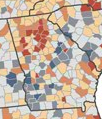It’s too bad they haven’t dedicated all this organizing to something that might actually help education around here, such as prison reform or preventing bright flight by squelching sprawl.9,000 and Counting!
Petition Drive Hits Key Milestone In Effort to Give
Valdosta Residents Opportunity to Vote on Unification
Plan to Attend Saturday Event at McKey Park to Join the Movement, Sign Petition(Valdosta, GA) The petition drive campaign giving Valdosta residents the chance to vote on school unificationreached a key milestone Friday when it topped its goal of 9,000 signatures.
The 9,000 signatures was the target set by the Community Unification for Educational Excellence (CUEE),which launched the petition drive May 12 after three years of planning. The minimum number of validsignatures needed to place the issue on the November ballot is 25 percent of registered voters in Valdosta, or7,375. The target figure of 9,000 represents a 22 percent increase over the minimum required and nearly 31 percent of all registered voters.
-jsq









